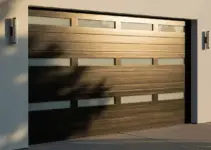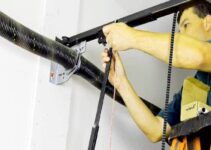Are you tired of struggling with your garage door? Are you looking for a solution to make your life easier? Look no further than garage door winding bars!
In this ultimate guide, we will cover everything you need to know about garage door winding bars, including what they are, how they work, and why they are essential for maintaining and repairing your garage door.
Garage doors are an essential part of any home, providing convenience and security for your vehicles and belongings. However, they can also be a source of frustration and inconvenience when they malfunction. That’s where garage door winding bars come in.
These simple tools are essential for maintaining and repairing your garage door, ensuring it operates smoothly and safely for years to come.

What are Garage Door Winding Bars?
Garage door winding bars are long, steel rods used to wind and unwind the springs on a garage door. They are essential for adjusting the tension on the springs, which allows the door to open and close smoothly.
Garage door springs are under a great deal of tension, and attempting to adjust them without winding bars can be dangerous and even deadly.
Types of Garage Door Winding Bars
There are two types of garage door winding bars: T-style and L-style. T-style winding bars have a T-shaped handle on one end and a winding cone on the other end, while L-style winding bars have an L-shaped handle on one end and a winding cone on the other end.
Both types of winding bars are effective for adjusting garage door springs, but T-style winding bars are generally considered to be easier to use.
How to Use Garage Door Winding Bars
Using garage door winding bars requires some knowledge and experience, but it can be done safely with the right tools and techniques. Here are the basic steps for using garage door winding bars:
- Unplug the garage door opener and lock the door in the down position.
- Locate the winding cones on the torsion spring. They will be located on either side of the center of the spring.
- Insert the winding bar into the winding cone, ensuring that it is securely in place.
- Use the winding bar to turn the cone counterclockwise, which will loosen the tension on the spring.
- Use a second winding bar to turn the opposite cone counterclockwise.
- Repeat this process until the tension on the spring is released.
- To tighten the spring, reverse the process by turning the cones clockwise.
Safety Tips for Using Garage Door Winding Bars
Using garage door winding bars can be dangerous if not done correctly. Here are some safety tips to keep in mind when using these tools:
- Always wear eye protection and gloves when working on garage doors.
- Make sure the door is locked in the down position and the garage door opener is unplugged before working on the springs.
- Use the correct size winding bars for the job.
- Keep your body clear of the winding bars and springs at all times.
- Work with a partner whenever possible.
Benefits of Garage Door Winding Bars
Using garage door winding bars offers several benefits, including:
- Increased safety: Properly tensioned garage door springs are crucial for safety, and winding bars allow you to adjust the tension safely and accurately.
- Cost savings: Regular maintenance and adjustments with winding bars can prevent costly repairs down the line.
- Convenience: With the right tools and knowledge, you can make adjustments to your garage door springs quickly and easily, without needing to call a professional.
Maintenance and Care for Garage Door Winding Bars
Like any tool, garage door winding bars require regular maintenance and care to ensure they continue to function properly. Here are some tips for maintaining your winding bars:
- Clean and oil your winding bars regularly to prevent rust and corrosion.
- Store your winding bars in a dry, protected area to prevent damage.
- Inspect your winding bars regularly for any signs of wear or damage, such as cracks or bends.
Common Garage Door Issues and How Winding Bars Can Help
Garage doors can experience a variety of issues over time, such as sagging, sticking, or failing to open or close. Many of these issues can be traced back to problems with the garage door springs, which are responsible for lifting and lowering the door. Winding bars can help with the following common garage door issues:
- Sagging: Over time, garage door springs can lose tension, causing the door to sag. Winding bars can be used to tighten the springs and restore the door’s proper alignment.
- Sticking: If your garage door is sticking or jerking as it opens or closes, it may be due to an imbalance in the springs. Winding bars can be used to adjust the tension on the springs and restore smooth operation.
- Failure to open or close: If your garage door won’t open or close at all, it may be due to a broken spring. Winding bars can be used to replace the broken spring and restore functionality to your door.
When to Call a Professional for Garage Door Repairs
While using winding bars can be a great DIY solution for many garage door issues, there are some situations where it’s best to call a professional. Here are some signs that you may need professional garage door repair:
- You hear grinding or scraping noises when the door opens or closes.
- The door is visibly damaged or bent.
- The door won’t stay closed or opens and closes on its own.
- The door is difficult to lift or lower, even with the help of winding bars.
What size winding bars do I need for my garage door?
The size of the winding bars you need depends on the size and weight of your garage door. It’s best to consult your garage door manual or a professional for guidance on the appropriate size.
Can I use one winding bar instead of two?
No, it’s important to always use two winding bars when adjusting the tension on your garage door springs. This ensures that the tension is evenly distributed and reduces the risk of injury.
How often should I adjust the tension on my garage door springs?
It’s recommended to have your garage door springs inspected and adjusted by a professional once a year. However, if you notice any issues with the operation of your garage door, such as sagging or sticking, it may be necessary to adjust the tension more frequently.
Are there any signs that my garage door springs need to be replaced?
Yes, there are several signs that your garage door springs may need to be replaced, including visible wear or damage, sagging or imbalance in the door, and loud creaking or snapping sounds when the door is in operation.
Can I adjust the tension on my garage door springs without winding bars?
No, winding bars are essential for safely adjusting the tension on garage door springs. Attempting to adjust the tension without the proper tools can be dangerous and can result in serious injury.
Conclusion
Garage door winding bars are an essential tool for maintaining and repairing your garage door. With the right knowledge and techniques, you can use these tools to adjust the tension on your garage door springs, ensuring that your door operates smoothly and safely for years to come.
Remember to always prioritize safety when working with garage door winding bars, and don’t hesitate to call a professional if you’re unsure about any aspect of garage door repair.


